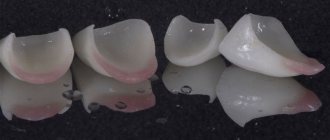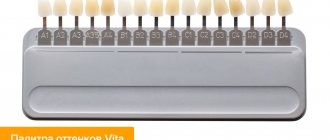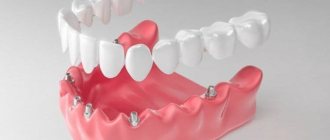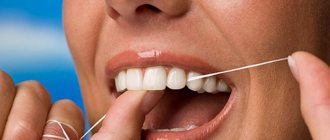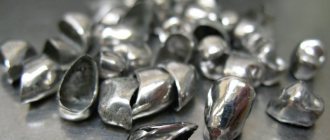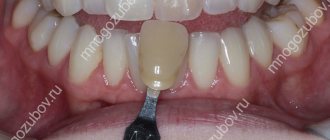What colors of teeth are there?
As a rule, the color of tooth enamel is milky white and translucent, but over the course of life, the tissue can become stained under the influence of various factors. The color of teeth depends not only, or rather not so much, on the enamel, but on the shade and quality of dentin, which shines through the enamel. The younger the person, the denser the layer of enamel on his teeth. In addition, the surface of the tooth is uneven, which means the light is reflected unevenly. The denser the layer of enamel is on the teeth and the more pronounced its surface microrelief, the less it shines through, and, therefore, the tooth looks whiter. Conversely, with age, the tooth surface smoothes out, the enamel layer decreases, and dentin begins to shine through more and more, the natural color of which is much darker than the enamel and can be light brown, yellow or gray. With age, the amount of enamel decreases, dentin also undergoes changes, and red-brown pulp begins to shine through the surface structures of the tooth, therefore, the teeth themselves acquire darker shades. It should be taken into account that dental tissues are usually colored unevenly over their surface: at the cutting edge the color is lighter than at the root. Different teeth also have different shades. For example, canines are often darker than incisors. Today, all age-related changes in the color of teeth are easily corrected by aesthetic dentistry, as well as any other problems associated with the appearance of the dentition.
Myth No. 1: Electric brushes and professional hygiene damage enamel
There is a strong opinion that electric brushes are too powerful for teeth, as a result of which they quickly wear away enamel and lead to the destruction of dental tissue. It is also believed that professional hygiene is performed with too active drugs, which is why the teeth become more sensitive.
In fact, many dentists are confident that high-quality electric brushes, on the contrary, provide equal pressure on the jaw, unlike conventional options. The main thing is to follow the technique. Hygiene is also beneficial.
“I would also add that the only disadvantage of an electric toothbrush is the high price. It is enough to bring it to the tooth, and it will clean it efficiently, without the need to put pressure on it. And professional hygiene is necessary for oral health. Brushing your teeth at home does not replace professional cleaning at the dentist every six months,” says Natalia Kadkalova.
Too tough. Is it possible to live to old age without caries and fillings? More details
Natural tooth color
Speaking about the natural color of teeth, one cannot fail to mention the characteristics of people with different skin tones. For example, during a recent comparative study of representatives of the Slavic and Iranian groups, scientists identified such a feature. People of the Slavic and Iranian groups most often have a red-brown tint of teeth, less often - reddish-gray. At the same time, among the Slavs, teeth can also be reddish-yellow, but among Iranians, this color was not found in the color of the teeth, as well as gray - in both one and the other group. A comparative analysis of other nationalities shows similar results, indicating that the color of teeth is largely influenced by genetic characteristics and, to a lesser extent, by the environment in which a person lives.
Many people think that people with black skin have beautiful white teeth, but most often this is not the case. African Americans' smiles simply appear brighter. A similar effect, by the way, is observed in tanned people, even those who have only spent a little time in the sun. Therefore, when answering the question of what color natural teeth should be, one should rely on many factors, including those listed above.
By the way, the American Dental Association claims that teeth with a yellowish tint are easiest to whiten. In second place is the brownish tint of the enamel, and the worst response to the whitening procedure is gray teeth, which are often found among Americans.
Optical properties of the tooth
The aesthetic function of a tooth is characterized by certain optical properties: shades, color saturation, lightness, as well as the “transparency” of the enamel. A substantive examination of the dentition and individual teeth makes it possible to reveal, albeit dim, but still its own rainbow of colors from transparent blue, grayish, white to various shades of yellow and light brown.
In addition to individual color, intact teeth have such qualities as a special shine of the enamel, opalescence, and the ability to fluoresce. Teeth may vary in color depending on their group affiliation (Fig. 1).
Rice. 1. Features of shades of color of permanent teeth.
Thus, the canines are usually darker (or yellower) than the incisors. At the same time, one of the most characteristic qualities of the dental arches is preserved - symmetry, in this case the similarity in the optical properties of the teeth located to the right and left of the sagittal plane. At the same time, the shades of individual areas of the tooth differ: the cervical area is characterized by yellowness, and the incisal edge is transparent bluish.
Aesthetic properties, including color, shine, opalescence, and fluorescence, are manifested due to optical laws (Fig. 2).
Rice. 2. Basic optical laws: reflection and refraction of light rays (diagram).
Tooth tissues are capable of reflecting, transmitting, and scattering light, which gives it its characteristic visual features.
Research methods
In the present study, the optical characteristics of the tooth were studied on one-sided or transparent sections of enamel and dentin, as well as intact crowns.
The spectra of diffusely reflected light were measured with an AvaSpec-2048 spectrometer (Avantes). The excitation source was an AvaLight-HAL-S halogen lamp (Avantes). The light passed through the optical fiber to the FCR-7UV400 fiber optic probe (Avantes). For optimal presentation of the obtained data, a correction was introduced to the spectral sensitivity of the recording system.
The spectra of fluorescent properties were measured at the Institute of Physics of the National Academy of Sciences of Belarus on an automated spectrofluorimeter SDL-2, consisting of an MDR-12 excitation monochromator and an MDR-23 registration monochromator. A DKsSh-120 xenon lamp was used as an excitation source. The registration of the light signal after passing through the monochromator was carried out using a cooled photomultiplier tube FEU-100 (range 230–800 nm) in photon counting mode. Correction of the recording system “monochromator MDR-23 - PMT”.
Steady-state fluorescence spectra were also measured using an SFL-1211A spectrofluorimeter (Solar) from the front surface of the samples. A total of 95 sections, 67 extracted and 120 vital teeth, were used in the study.
Visual assessment of tooth color characteristics
The qualitative characteristics of tooth color were considered tone, lightness, and saturation. Visually perceived tones, or shades, can be described as white, yellow, gray, blue, brown. The tones vary in lightness as follows: yellow varies; gray, blue are light; brown - very light. The following gradations can be distinguished by saturation: yellow tones vary; Grays and blues are characterized by low saturation, while brown shades are characterized by very low saturation. Quantitative, or alphanumeric designation of parameters in the clinic allows you to determine the VITA color scale, VITA-3D-MASTER.
Analysis of the optical properties of vital teeth in patients of the younger age group showed a predominance of shade B2 - 36.7%. Shade A2 was detected in 13.3%, tones A3 and C2 - 3.3% each. The combination A2/A3 was 20%, A1/A2 - 10%, B1/B2/B3 - 6.6%.
In patients of the next age group, among vital teeth, shades A3/A3.5 and 23.4% B2/B3 were identified in 76.6% of cases, which corresponds to the average intensity (and lightness) of color.
The color of the vital teeth of older patients in 78% of cases corresponded to shades A3/A3.5 and in 22% B2/B4, which characterizes medium intensity.
When visually determining the initial color of 27 extracted teeth using the VITAPAN 3D-MASTER scale, it was found that the most common color was 2L2.5 (8 teeth), which amounted to 30%. A slightly less common color was identified that was two conventional shades darker than 2M3 (6 teeth). 4 teeth had shade 2M2, 3 teeth had shade 3M2; in isolated cases there were teeth lighter or darker than the indicated shades (Fig. 3).
Rice. 3. Determination of the shade of the extracted tooth.
The thickness of the dentin under the enamel layer had a significant influence on the determined shade of the tooth. After removing a thin layer of peripulpal dentin, in the vast majority of cases (21 teeth), the shade of the tooth did not change; in three cases it became lighter by 2 conventional numbers, in two cases by 3, and in one case by 5 conventional units.
After removing a thick layer of dentin, in 3 cases the color was similar to the initial definition, in 4 teeth it became half a tone lighter, in 8 - by one tone, in 8 - by two tones, in 1 - by 2-2.5 tones. Removal of the bulk of the dentin of these teeth caused an increase in lightness in the vast majority of cases by 2 and 1 tone, rarely by 3 tones and a semitone, by 4 tones in one case (Fig. 4).
Rice. 4. Increasing the lightness of the extracted tooth after excision of the dentin layer.
One tooth remained the same color as before preparation.
Optical properties of fabrics
Hard tooth tissues are distinguished by their ability to reflect the entire spectrum of incident light. In this case, the diffuse reflectance coefficient of enamel and dentin presents pronounced individual fluctuations.
A study of the reflectivity of intact teeth showed that the coefficient of diffuse light reflection (R, %) from their surface ranges from 12 to 17 in the short-wavelength part of the spectrum and from 18 to 28 in the long-wavelength part. At the same time, the rate of young teeth is 6-10% higher than that of mature teeth. The decrease in diffuse reflection with age is explained by changes in the composition and structure of hard dental tissues. The inclusion of pigments increases the selective reflection of color rays.
The scattered radiation flux (j) from the surface of intact immature teeth is significantly higher than from the surface of mineralized teeth. With a radiation detection angle of 60º, the intensity of scattered radiation is 0.8 for a young tooth and 0.4 for a mature tooth. These values are close to those of the standards for enamel and opaque photopolymer colors.
The light transmittance of a tooth depends on the wavelength of transmitted light. The spectrum of transmission of a light beam by a young tooth contains rays of all wavelengths. For a mature tooth, in the short-wave part of the spectrum (400 nm), the transmittance is reduced to a minimum, i.e., mineralized and pigmented tissues transmit less “blue” waves.
The light conductivity of young teeth in terms of the diffuse absorption coefficient (T, %) coincides with the standards of composite materials A10, A20, A30. The light transmission of mature ones is similar to photopolymers - A35, C20, C40 (Fig. 5).
Rice. 5. The optical properties of enamel are comparable to photopolymer.
The optical properties of a tooth are formed by a combination of parameters of hard tissues and dental pulp. A study of the characteristics of the interaction of light with the surface of enamel sections showed the high reflective abilities of this fabric. Thus, the diffusion reflection coefficient of enamel (R) ranges from 20 to 42%, characterizing the high brightness of the sample.
The spectrum of light reflected from the surface of the enamel contains rays of any wavelength. Consequently, enamel has the ability to reflect the entire spectrum of color, which is typical for a white surface. Therefore, the prevailing shade of enamel is white (Fig. 6).
Rice. 6. Pronounced whiteness of the central group of teeth.
In this case, the maximum reflection occurs at a wavelength from 400 to 600 nm (usually the violet-blue region or yellow-orange). The red part of the spectrum is characterized by the lowest percentage of ray reflection.
For comparison, the reflective abilities of the Charisma photopolymer (according to the diffuse reflection index, R, %) range from 5 to 32. Samples A10, B10, B20 are closest to the reflectance index of enamel.
The enamel of a “young” tooth has higher rates of diffuse light reflection compared to mineralized, mature enamel. The difference in reflection coefficients is minimal in the long-wavelength part of the spectrum and reaches 10% in the short-wavelength range. That is, young enamel reflects more blue-blue waves than “mature” ones. The diffusion reflection of light from the surface of tooth enamel in any age group is higher than that of dentin.
The structural features of enamel give it the ability to scatter rays - reflect light in different directions. When the beam is incident at an angle from 0 to 50º, the lowest flux of scattered radiation is recorded from the surface of the enamel of a mature tooth. The highest amount of scattered radiation is observed in the area of the enamel-dentin junction. The enamel of immature teeth is characterized by relatively high rates of light scattering, which helps reduce the enamel’s shine and color, thereby increasing the whiteness of the tooth crown (Fig. 7).
Rice. 7a. Optical characteristics of “immature” teeth. Rice. 7b. Optical characteristics of highly mineralized teeth.
The internal scattering of light by enamel, in addition, imparts the property of opalescence - internal play of light and color. By analogy with precious stones (opals) containing 10% water, it can be assumed that the property of opalescence depends on micropores and dental cerebrospinal fluid. Drying the enamel leads to a loss of this quality.
The blue shades of the tooth are also partly due to the scattering abilities of the enamel: refraction and reflection of short wavelengths create a blue-blue color.
Possessing the ability of diffusion reflection and scattering of light, enamel is also characterized by the property of transmitting light rays. This phenomenon is called transmission. Penetrating the enamel and passing through the crystal, the light beam is split into two beams, each of which has its own angle of refraction. The refractive index for apatite (the main structural unit of tooth enamel) is 1.63-1.64.
The property of enamel to partially transmit and partially scatter light rays is characterized by light conductivity (Fig. 8).
Rice. 8. The property of light conductivity gives the object volume and depth of perception.
The thickness of the layer has a significant influence on the light conductivity of the enamel. The coefficient of diffuse light transmittance (T, %) studied on enamel sections 1 mm thick ranges from 3 to 18. Depending on the wavelength, T, % is 10-18 for the enamel of a young tooth and from 3 to 10 for a mineralized one.
The inherent property of light transmission of enamel allows rays selectively reflected from dentin pigments and the enamel-dentin junction to pass through the enamel and be perceived by the eye as the color of the tooth.
In certain areas of the tooth, the enamel does not have underlying dentin and is perceived as transparent: the cutting edge and proximal surfaces (Fig. 9).
Rice. 9a. A transparent layer of enamel on the cutting edge of intact teeth. Rice. 9b. A transparent layer of enamel on the cutting edge of worn teeth.
The thinning of the enamel layer allows dentin to show through in other areas (Fig. 10).
Rice. 10. Translucent dentin of the lateral incisor through thinned enamel.
Dentin has a lower diffuse reflectance coefficient than enamel in all age groups. On samples of “mature” teeth, the proportion of the red part of the spectrum increases (wavelength above 600 nm). This picture is explained by the accumulation of pigments in dentin with age.
The diffuse reflection coefficient of “young” dentin (R, %) is 20-35. Moreover, for short waves this figure reaches 20-22% and 30-36% for long waves (orange-red). Thus, the reflectance in the long-wave part of the spectrum is higher than for short waves. In mature dentin this difference is lower than in young dentin (up to 15%).
Due to the property of selective reflection (the ability to reflect waves of a certain length to a greater extent), dentin forms the color of the tooth (Fig. 11).
Rice. 11. Individual shades of the central teeth are determined.
The ability of dentin to selectively reflect depends on the pigments it contains, which react differently with light of different wavelengths. As a result, rays of different colors are reflected to a greater or lesser extent and are summed up, forming a yellowish color of dentin (Fig. 12).
Rice. 12. The main shades of dentin are yellowish, orange, brown.
Since the primary colors of the spectrum are represented by blue-yellow-green-red tones, tooth shades are secondary, tertiary from the summation of the primary (primary) colors. The scattering ability of dentin is significantly higher than that of tooth enamel. The highest rate of scattered radiation is recorded from the enamel-dentin junction (EDJ), which has larger and more heterogeneous particles of the substance.
The surface of young dentin has a dispersion index higher than mature dentin. The intensity of the scattered radiation flux when the beam is incident at an angle of 60º for EMF is 0.85, for dentin 0.7-0.8, for enamel - 0.2-0.5.
The light transmittance of dentin is always lower than that of enamel (at any age). The thickness of the layer of tissue being studied has a significant influence on the conductivity of light. The opacity and opacity of dentin depends on the scattering of light and low light conductivity associated with the heterogeneity of structure and composition.
A special property that gives a tooth an individual visual perception is associated with the ability to fluoresce (Fig. 13).
Rice. 13. Fluorescence of intact parts of the incisors and extinguishing of the glow in the area of restoration are noted.
Short-wave ultraviolet (λ < 400 nm) rays are not perceived by the human eye, but when objects are irradiated with ultraviolet light, a glowing effect (fluorescence) can occur. The phenomenon of fluorescence depends on the ability of individual objects to absorb radiant energy in the short-wave part of the spectrum. In this case, part of the energy is emitted in the visible range of light.
The fluorescence amplitudes from the enamel surface are characterized by low luminescence values - 2750-130 rel. units in the wavelength range from 450 to 480 nm for weakly mineralized enamel and 2200-130 rel. units at a wavelength of 500 nm for highly mineralized enamel. The course of their spectral curves also differs (Fig. 14).
Rice. 14. Fluorescence intensity of hard dental tissues: 1 - enamel-dentin junction of a weakly mineralized tooth; 2 - enamel-dentin junction of a mineralized tooth; 3 - weakly mineralized dentin; 4 - mineralized dentin; 5 — intact tooth of a patient of the “younger age group”; 6 — intact tooth of a patient in the “older age group”; 7 - low-mineralized enamel; 8 - mineralized enamel.
A study of the fluorescent activity of dentin showed that the fluorescence intensity of “young” dentin is on average 2500–130 rel. units higher than in highly mineralized teeth of patients in the older age group.
The maximum fluorescence from the surface of weakly mineralized dentin (10,500–149 relative units) is observed at a wavelength of about 460 nm. The fluorescence peak of highly mineralized dentin (amplitude 8,000–141 relative units) lies in the wavelength range from 460 to 500 nm.
The highest fluorescence intensity values were recorded for the enamel-dentin junction - EDS. In this case, the emission coefficient from the surface of the EMF of the teeth of young patients reaches its highest value (16,400–162 relative units) at a wavelength of 450 nm. The peak fluorescence intensity from the EDS of teeth of patients in the older age group is observed at a wavelength of 465 nm and corresponds to 12,500-152 rel. units
The fluorescent activity of intact teeth of patients of different age groups varies slightly. The fluorescence peak of intact teeth in young patients corresponds to 4500–138 rel. units at a wavelength of 470 nm, and in patients of the older age group - 4250 -138 rel. units at a wavelength of 475 nm. The fluorescence spectra of intact teeth of patients of different age groups also practically do not differ from each other. However, even with the same color, their fluorescent glow varies in intensity.
The fluorescence emission power of a tooth depends on the angle of irradiation with ultraviolet light. The maximum is located in the blue part of the spectrum, ranging from 440 nm to 450 nm. The “dome” of the graph is within the wavelength spectrum of 400-480 nm (blue-violet part of the spectrum), which explains the visual perception of tooth fluorescence in blue-violet color.
The data obtained can be interpreted as follows. The enamel-dentin junction and dentin of teeth have high fluorescence intensity (16,400-162 and 10,500-149 relative units), however, in intact teeth, the fluorescence intensity is partially “quenched” by enamel, which has a low level of luminescence. As a result, the light emitted by dentin and EMF loses its original intensity.
Exposure of dentin to a bleaching agent does not affect the fluorescence spectrum or shifts the maximum of the graph within 20 nm (blue part of the spectrum). Tooth whitening also does not have a significant effect on the fluorescent properties of enamel.
The role of pulp in the formation of tooth color
The intense red color of living tissue plays an important role in the aesthetics of natural teeth.
Depulpation of a tooth can lead to a change in optical properties. So, if when determining the color in the vital teeth of young people, shades B2 and A2 prevailed, which corresponds to high lightness, in pulpless teeth - shades DG and A4 (33.3%) - high intensity.
When examining pulpless teeth in people of the middle age group, shades C2/C4 and D3/D4 prevailed in 70% of cases instead of A and B, characteristic of intact teeth, which also corresponds to high intensity. In 30% of cases, the shade remains, but the color saturation increases, which is accompanied by a decrease in lightness. In the pulpless teeth of older patients, the predominant shade was C2/C3/C4 (76.7%), that is, medium and high intensity. In 23.3% of cases, the shade of A2/A3 teeth remained the same as in intact teeth, but the color saturation increased - A3.5/A4.
Thus, if vital teeth are characterized by high lightness, then pulpless teeth are characterized by high saturation (Fig. 15).
Rice. 15. High intensity shades of the color of the pulpless tooth.
A study of extracted teeth showed that the introduction of red color standards into the intact dental cavity or after removing a small layer of peripulpal dentin did not change the perception of enamel color. The use of standards imitating the color of the pulp after removal of the bulk of the dentin did not affect the color of the teeth in only 5 cases. In 22 cases, a reddish tint was visually detected through the thinned tissues.
When using red standards placed in the tooth cavity after removing the bulk of the dentin, a red tint was always visible to a greater or lesser extent through the remaining enamel.
Analysis of the results of clinical and laboratory studies indicates the significant role of pink pulp in the formation of the perceived color of the tooth. Moreover, this influence extends not only to shades, but also to lightness:
- The difference in the average values of diffuse reflection coefficients of teeth of patients of the “younger” age group with and without artificial pulp is 1.7% for incisors, 2.6% for canines, 4.0% for premolars, 1.5% for molars %.
- In the group of middle-aged patients, the difference between the average values of the reflection coefficients of teeth, the cavity of which was filled with dye, and without it was 7.0% for incisors, 8.0% for canines, 3.8% for premolars, and 2.6% for molars. %.
- The values of the diffuse reflection coefficients in the teeth of patients of the “older age group” with and without dye differ: for incisors with a preserved tooth cavity, the difference is on average 4.5%, for incisors with an obliterated cavity - 1.2%, for canines - 11, 9%, for premolars - 2.6% and for molars 2.5%.
The greatest difference is characterized by the canines, which have the widest and most voluminous tooth cavity: light reflected from the pulp passes through mineralized, translucent dentin and enamel, influencing the overall shade of the tooth.
Reflection coefficients from the surface of the teeth of patients in the “older age group”, who have a relatively wide tooth cavity and a small thickness of the vestibular wall, are higher than from the surface of the teeth of patients with an obliterated pulp chamber. The highest values of reflection coefficients are shifted to the long-wave region of the spectrum, corresponding to red-brown shades. Consequently, the teeth of older patients, due to the influence of light reflected from the pulp, can acquire additional shades.
Moreover, reflectivity depends on the size of their cavity and the thickness of the walls. Transparent, thinned enamel and glassy mineralized dentin partially transmit the light flux of red waves reflected from the pulp.
Conclusion
The aesthetic function of a tooth is ensured by the characteristics of its morphology and includes the symmetry of location, size, crown surface relief, as well as optical properties. Odontometry and odontoscopy make it possible to evaluate clinical anatomical signs, and optical laws such as the rules of reflection, transmission, and scattering of light explain the shades, shine, and ability to fluoresce and opalest that are characteristic of a tooth.
Color characteristics, in turn, are associated with the characteristics of the complex structures of enamel and dentin, which have been sufficiently studied. Much less understood are the mechanisms of influence on the color of the tooth by the pulp, the abundant blood supply of which gives it a bright pink color.
The basic tones of a tooth, their intensity (lightness and saturation) can be explained by the combination of optical properties of enamel, dentin, and pulp.
The maximum reflection of all colored rays by the enamel surface causes white color. In addition, having a tendency to internally scatter light, enamel imparts blue shades to the color scheme.
The color of dentin can be assessed due to the light transmittance of the enamel. The thickness of the enamel layer determines the degree of refraction and reflection of the incident light by the underlying dentin. The incisal area does not have dentin, so it is more transparent. The middle part of the tooth often contains the bulk of yellowish dentin, which determines the color of the tooth as a whole. In the cervical area of the tooth, the layer of enamel is thinner, so the color of the underlying dentin is more clearly expressed and exhibits many color shades.
The maximum reflection of all colored rays by the enamel surface causes white color. The tendency of enamel to internally scatter light gives blue tints to the color range. A small proportion of organic matter and water, which have different optical properties than the crystalline inorganic components, causes internal scattering of incident light due to differences in refractive index, very similar to the optical effect in opals. Hence the property of teeth to become opalescent. In addition, teeth have the ability to fluoresce. Due to the property of enamel to partially transmit and partially scatter light, the appearance of volume is added to the color of the tooth. Opacity gives depth of perception.
The age-related characteristics of the optical properties of a tooth can be collectively presented as follows. A young tooth with its surface reflects more light than a mature one, while having a high scattering ability. Its dentin contains less pigments. As a result, white color predominates in the reflection spectrum, and the enamel surface has a relatively low gloss level.
A mature tooth is characterized by a reduced scattering ability of the enamel, and at the same time there is an increase in the selective reflection of dentin, which gives the tooth its inherent shade. With age, the color of the tooth changes, but the shade may remain the same, its saturation increases and its lightness decreases. Mature teeth correspond to VITA shade groups A and C. High intensity: A30-35, C20-40.
Age-related changes in the optical properties of a tooth, namely a decrease in whiteness, an increase in shine, and a change in color, are associated with age-related transformations in the structures of enamel, dentin, and pulp. Moreover, the higher the degree of mineralization of enamel and dentin and the larger the size of the tooth cavity, the more significant the contribution made by red light reflected from the pulp.
The list of references is in the editorial office.
How to choose teeth color
The practice of an orthopedic dentist involves the need to choose the shade of dentures. When making prosthetics or restoring one or more teeth in a row, the color is selected in accordance with the patient’s natural teeth. When making complete removable or fixed orthopedic structures, the patient has the opportunity to choose the desired color of the teeth. In this case, you should focus not only on your own desires, but also on the shade of your skin, hair and eye whites. Typically, teeth that are much lighter than the whites of the eyes look unnatural and stand out too much when you smile. In addition, the material from which the crowns or veneers are made should also be taken into account. Thus, plastic and composite materials used to restore teeth look different than metal-ceramics, even with the same color index.
Please note that the color of teeth will be perceived differently in different lighting conditions. That is why, when choosing the shade of veneers or dentures, it is necessary to follow a whole list of conditions, such as natural light, neutral color of the walls in the room and the clothes of the patient and the doctor, the absence of bright lipstick on the lips, and so on.
Advice from Dr. Zubastik
Don't like the color of your teeth? Don't worry, the problem can be solved. If you wish, you can buy a special set of mouth guards and lightening gel and lighten the enamel at home.
But first, consult your doctor: he may advise you to limit yourself to ultrasonic cleaning. In this case, the teeth will become half a tone whiter.
If it’s not enough, use a professional whitening service or install veneers. The main thing is that in pursuit of beauty, do not forget about dental health. Frequent bleaching weakens the enamel. Maybe it’s better to agree with what nature gave - after all, yellowish enamel is really a little stronger than ideal white?
Do you want to lighten your enamel? Watch how it happens:
Tags: Baby teeth, whitening, Teeth color, Vita scale
About the author: Dr. Zubastik
Typically, a toothache begins to subside on the way to the clinic and finally goes away after 10 minutes of sitting in line to see the dentist.
- Related Posts
- What to do if your tooth hurts during quarantine?
- Waxed and unwaxed dental floss: the difference
- Classification of caries: all types
« Previous entry
Definitions of tooth color
When making dentures, technicians are guided by a special tooth color chart. According to the Vita scale, which is used by almost all dental clinics in the world, natural teeth can have only a few shades: brown, yellow, gray and red. Depending on the intensity category, colors are designated by numbers from 1 to 4. Thus, if a dentist talks about tooth color under the index A1, he means the lightest shade from the reddish-brown range of the table, accordingly, A2 will be slightly darker, A3 - even darker. Index B corresponds to the yellow tone of the teeth and varies in the same way according to the lightness of the shades (B1, B2, and so on). The gray shade is indicated by the Latin letter C (C1, C2, and so on), and reddish-gray teeth - D (namely Latin, not Russian D). The numerical index of the scale indicates the intensity of the color and starts from one, so tooth color 0 actually does not exist.
How does a doctor determine color?
The dentist takes a scale (it can be made of paper or polymers) and brings it to the patient’s dentition.
Determination of color according to the Vita scale
If your healthy teeth are naturally grayish, the doctor will choose group C and then begin working with it. Each group has its own subgroups, that is, shades of varying degrees of brightness. There are also 4 of them. In the group C we are considering, the most “inconspicuous” brightness will be in shade C4, while the most “powerful” will be in shade C1.
Having studied the characteristics of the color of the patient’s teeth, the dentist determines the color scheme of the filling or material that will be used for prosthetics.
How to whiten yellow teeth: 3 effective ways
naturally yellow teeth are the most resistant to the environment . “Everything is good in moderation” is a light shade, it’s natural.
Doctors say that the healthiest teeth are shiny ones, because only healthy enamel always has shine. If your smile has faded, and your teeth have clearly changed their color, losing their attractiveness, it’s time to contact a specialist.
How to whiten yellow teeth - progressive and safe ways:
- Ultrasonic whitening . The most gentle way to return your teeth to their natural color and shine. It is carried out with a special device using an ultrasonic scaler. There is no direct contact with the surface of the teeth - deposits are destroyed by ultrasonic waves and washed away with a stream of water. After professional teeth cleaning, your smile brightens by 3-5 tones.
- Laser whitening . Painless and effective method. The laser beam precisely targets the tartar, leaving the enamel unharmed. As a result, teeth become up to 10 shades whiter. The procedure takes about 60 minutes. The result lasts from six months to 2 years.
- Beyond method . Progressive American technology of teeth whitening Beyond. It is used in several leading clinics in Ukraine, Healthy Dent is among the selected ones. Exclusive LightBridge lamp equipment is used (halogen and LED lamps. Light exposure to teeth coated with whitening gel gives an amazing effect: the enamel is lightened by 5-12 tones in just 45 minutes!
what to do if your teeth are yellow , now let’s talk about prevention.
A dazzling smile every day: recommendations from experts
The following rules will help preserve the natural shine of enamel:
- regular dental care: brushing 2 times a day, using additional products (floss, rinses);
- moderate consumption of coloring products;
- stop smoking or brush your teeth after each cigarette;
- proper nutrition, rich in vitamins and minerals.
Where yellow teeth come from, the reasons and methods for safe whitening are no longer a secret. A careful and attentive attitude to the enamel and discoloration (discoloration) will definitely not threaten your teeth. Smile more often and brightly!
Myth #7: Wisdom teeth should be removed preventively, even if they don’t hurt at all.
Wisdom teeth are the subject of fierce debate among both doctors and ordinary people. Everyone and everyone is speaking out on the topic of the ill-fated eights. There is an opinion that it is better to remove them in advance, even if such teeth do not bother you at all. And there is some truth in this statement. “I have always said and will continue to say that eighth teeth do more harm than wisdom. It is extremely rare that they erupt correctly due to the fact that they do not have enough space in the jaw, and thus cause many problems for patients. And even if they erupt smoothly, patients cannot clean them efficiently, pathogenic microorganisms constantly accumulate there, and caries appears. Thus, a constant inflammatory process occurs in the oral cavity. That’s why we’re deleting!” - says the dentist.
Myth #4: After eating you should brush your teeth with a toothpick.
Toothpicks are offered in different types: with and without flavors, figured, regular. At the same time, while using toothpicks, many people forget about other options for oral hygiene. And they are sometimes of better quality than wooden sticks with sharp tips.
“As I like to say, a toothpick is a great endodontic tool. I do not recommend using it under any circumstances. It’s better to use dental floss,” the dentist notes. It is also worth remembering that today there are irrigators to provide better dental hygiene.
General presentation and purpose of the Vita scale
A standardized dental set is used for visual comparison and selection of a suitable shade for prosthetics or dental fillings. In the original version, the kit is called Vitascale.
The professional dental kit is produced by the German company Vita. It comes in containers with cells. Each contains a reference shade sample. Color layouts are fixed on a plastic handle-holder.
Each tone of the visual ruler is assigned an alphanumeric code. The Vita scale is divided into 4 categories. The color range is presented in the table.
| Designation | Shade range | Numbering of color options |
| A | Brown-reddish shades | 1, 2, 3, 3.5, 4 |
| IN | Red-yellow range | 1, 2, 3, 4 |
| WITH | Gray palette | 1, 2, 3, 4 |
| D | Reddish-gray color scheme | 2, 3, 4 |
The Vita scale shades correspond not to the color of tooth enamel, but to the hard dentin tissues located underneath it. The observed shade of the jaw elements is influenced by light aberrations.
The rays are refracted in dense dentin structures when passing through a translucent enamel layer, which creates a coloring effect. Tint models are made of thick cardboard, polymer or ceramic material.
The latter are considered the highest quality, accurately conveying color nuances. They are recommended for use in dental clinics and aesthetic medicine centers.
Ceramic standards guarantee maximum accuracy in individual selection of the shade of a crown, implant or filling mixture. The material is valued for its visual proximity to the texture of natural tooth enamel.
The original German-made Vita scale palette consists of 16 shades. During professional whitening, installation of veneers or dentures, the dentist assesses the condition of the oral cavity and visually compares the ceramic sample with the jaw elements.
To ensure maximum accuracy and eliminate the subjective visual factor in profile blades, digital technologies are becoming increasingly widespread, replacing physical Vita sets with three-dimensional computer models.
The most famous program is Digital Smile Design. Using software, a smile is projected from different angles after a restoration procedure. The software contains the standard 16 shades of the Vita scale in digital format.
DSD allows you to plan in detail therapeutic or installation measures using an electronic scanning device to determine the closest to the natural color of the enamel layer of the filling composition or implant.
The Vita scale in its physical form is a shade palette printed on laminated cardboard, acrylic or hard glossy paper. The range of teeth colors exactly matches the natural range of jaw elements.
When choosing a composite material for prostheses, special devices with retractable ceramic models are used. This shade chart has proven itself well in the field of artistic restoration of the jaw apparatus.
The higher the digital index of the sample, the duller the color it has. Models with a smaller designation are lighter and brighter. They are closer to the standard and aesthetically impeccable snow-white shade.

